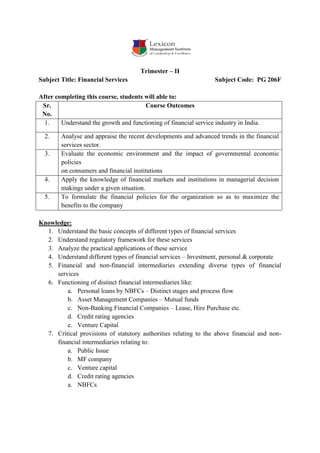Financial Services Syllabus.docx
- 1. Trimester ŌĆō II Subject Title: Financial Services Subject Code: PG 206F After completing this course, students will able to: Sr. No. Course Outcomes 1. Understand the growth and functioning of financial service industry in India. 2. Analyse and appraise the recent developments and advanced trends in the financial services sector. 3. Evaluate the economic environment and the impact of governmental economic policies on consumers and financial institutions 4. Apply the knowledge of financial markets and institutions in managerial decision makings under a given situation. 5. To formulate the financial policies for the organization so as to maximize the benefits to the company Knowledge: 1. Understand the basic concepts of different types of financial services 2. Understand regulatory framework for these services 3. Analyze the practical applications of these service 4. Understand different types of financial services ŌĆō Investment, personal & corporate 5. Financial and non-financial intermediaries extending diverse types of financial services 6. Functioning of distinct financial intermediaries like: a. Personal loans by NBFCs ŌĆō Distinct stages and process flow b. Asset Management Companies ŌĆō Mutual funds c. Non-Banking Financial Companies ŌĆō Lease, Hire Purchase etc. d. Credit rating agencies e. Venture Capital 7. Critical provisions of statutory authorities relating to the above financial and non- financial intermediaries relating to: a. Public Issue b. MF company c. Venture capital d. Credit rating agencies a. NBFCs
- 2. Skills: 1. Thirst and urge for knowledge related to various recent developments in financial sector and the economy. 2. Determining EMI for a lease/HP deal 3. Drawing up the time table for a public issue 4. Drawing up the process map for credit rating, venture capital deal etc. Attitude: 1. To be a continuous learner understanding role of financial services in the growth of the trade and commerce. Topics to be covered: Unit No. Contents Chapter Outcome Session (in Hours ) 1 Structure of Financial System ’éĘ Role of Financial System in Economic Development ’éĘ ŌĆō Financial Markets and Financial Instruments ŌĆō Capital Markets ŌĆō Money Markets ŌĆō ’éĘ Primary Market Operations ŌĆō Role of SEBI ŌĆō Secondary Market Operations ŌĆō ’éĘ Regulation ŌĆō Functions of Stock Exchanges ŌĆō Listing ŌĆō Formalities ŌĆō Financial The learner ’éĘUnderstands the concept of Financial Services ’éĘUnderstands about Project Counseling and Appraisal ’éĘis familiar with the Procedural aspects of IPO ’éĘUnderstands SEBI guidelines for Merchant Bankers 3 2 Financial Services and Merchant Banking ’éĘ Concept, Nature and Scope of Financial Services ŌĆōŌĆō Growth of Financial Services in India ŌĆō Merchant Banking ŌĆō Meaning- Types ŌĆō Responsibilities of Merchant Bankers ŌĆō Role of Merchant Bankers in Issue Management ŌĆō Regulation of Merchant Banking in India. The learner ’éĘUnderstands the types and procedures related to personal loans and investment products ’éĘunderstands the concept of importance of NBFC's in Indian economy, ’éĘunderstands the concept of Mutual Funds ’éĘknows the recent guidelines of SEBI and AMFI with regard to Mutual Funds 4 3 Mutual Funds ’éĘ Concept and Objectives, ’éĘ Functions and Portfolio Classification, The learner ’éĘ Is familiar with the leasing works and how 4
- 3. Organization and Management, Guidelines for Mutual Funds, ’éĘ Working of Public and Private Mutual Funds in India, ’éĘ Debt Securitization ŌĆō Concept and Application ŌĆō De-mat Services - need and Operations-role of NSDL and CSDL. calculations are done & different types of leasing ’éĘ Is able to distinguish between Leasing and Hire Purchase ’éĘ understands the concepts of factoring, forfaiting and bills discounting and can distinguish between them ’éĘ has a general understanding of merchant banks, venture capital and credit ratings 4 Allied Financial Services Venture Capital ŌĆō Growth of Venture Capital in India ŌĆō Financing Pattern under Venture ’éĘ Capital, Leasing ŌĆō types of Leases ŌĆō Evaluation of Leasing Option Vs. Borrowing, ’éĘ Credit Rating ŌĆō Meaning & Functions, Insurance Services, ŌĆō Factoring ŌĆō Forfaiting The learner ’éĘ understands of the procedures and calculations regarding the cash flows in factoring, bills discounting and forfaiting ’éĘ is aware of the WTO regulations pertaining to the same 4 Total 30 RECOMMENDED TEXT BOOK 1)Financial Services, M.Y. Khan, 9th Edition, McGraw Hill Education (India) Private Limited 2)Bhole. L.M. and Jitendra Mahakud ŌĆ£Financial Institutions & Markets ŌĆō Structure, Growth & InnovationsŌĆØ, TMH latest edition. 3) "The Indian Financial System- Market, Institutions and Services", Bharti Pathak, latest Edition, Pearson, REFERENCE BOOKS Reference Books 4)"Financial Markets and Institutions",Frederic S. Mishkin Graduate, G. Eakins, latest edition, Pearson Pub. 5) "Financial Markets and Institutions" Frederic S. Mishkin & Stanley G. Eakins, latest Edition, Pearson
- 4. Online Resources: 1. www.cfoasia.com 2. http://economictimes.com/ 3. http://www.sebi.gov.in 4. https://www.cfo.com/source/cfo-asia/





